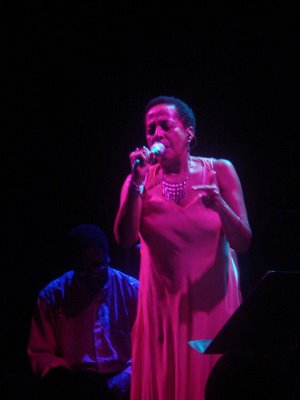Thomas Dolby, 5.03.06, Joe's Pub

by Charlotte Deaver
Twenty-five years after his hit record, The Golden Age of Wireless, and over fifteen years after releasing much music at all other than ringtones, Thomas Dolby is once again on tour. Performing mostly old (but some newer) material at Joe's Pub last month, he sang as he twirled around numerous buttons and knobs for a loyal audience of once-and-long-time fans.
Even if you don't know the name of the song, most of us have heard his hit from the early 1980s, "She Blinded Me With Science." I remember the entire record, though, so it was fun to hear all those songs, like "One Of Our Submarines" and "Radio Silence."
Thomas Dolby wants to show us that he's a conceptual artist, but his music is pure pop. And there's something super pretentious about that. Clearly a shy sort of fellow, he comes across as one who doesn't get out of his basement or behind the great curtain very often. What would his body do on stage without all that equiptment? It's practically prosthetic, he's so tethered to it. He presents himself as some kind of technological Nordic wizard, wearing a huge, burdensome trenchcoat, which he shed, thankfully, mid-set. And all the while, let's face it: he's going for the rock beat, and so are we. He made a big deal about wishing he didn't have to play his major hit, kind of complaining about it a bit. But why? That's his bread and butter! That's his gift horse. I just wanted to shout, "Get over your ass and PLAY THE SONG!" (Some friends of mine will be pleased to hear that I did NOT, in fact, shout anything to the performer that night.)
And all those machines: what are they? In an interview for NPR he explained that although the sound source for most of the music was his computer, he has a "fetish for big dials and knobs." Taking old field measurement equipment from royal navy or us airforce, including an Ascylascope from the 1940s, he "gutted them out and retro-fitted them for midi."
Because he's all alone up there on stage, looking slightly freaky and uncomfortable, (playing with himself, playing with his toys) I found myself wondering what kind of music he listens to, if he goes to see live music, if he's married and if his wife brings him dinner everynight in his vast, sprawling (I imagined) basement, like the scientist in the movie "The Fly." A shortish, stocky guy, he definitely works out a lot (but not, of course, at a public gym (I'm making this up completely): he's got more equipment in his basement for that).
It's as though he really WANTS to get funky, but can't quite do it, socially; he has to do it by himself. This is a guy who's got a lot more fetishes, or SHOULD have a lot more fetishes, than for just dials and knobs. He's not someone who would ever tour with a band, even though some fat bass and guitars would generate a lot of heat for an otherwise dry, masterbatory, and even perhaps narcissistic performance that is geared towards nostalgia, and not, unfortunately, for immediacy.

































